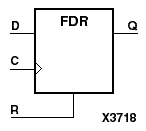Libraries GuideChapter 5: Design Elements (F5MAP to FTSRLE)
FDR
D Flip-Flop with Synchronous Reset
XC3000
| XC4000E
| XC4000X
| XC5200
| XC9000
| Spartan
| SpartanXL
| Spartan2
| Virtex
|
|---|
Macro
| Macro
| Macro
| Macro
| Macro
| Macro
| Macro
| Primitive
| Primitive
|

FDR is a single D-type flip-flop with data (D) and synchronous reset (R) inputs and data output (Q). The synchronous reset (R) input, when High, overrides all other inputs and resets the Q output Low on the Low-to-High clock (C) transition. The data on the D input is loaded into the flip-flop when R is Low during the Low-to-High clock transition.
The flip-flop is asynchronously cleared, output Low, when power is applied. For CPLDs, the power-on condition can be simulated by applying a High-level pulse on the PRLD global net. FPGAs simulate power-on when global reset (GR) or global set/reset (GSR) is active. GR for XC3000 is active-Low. GR for XC5200 and GSR (XC4000, Spartans, Virtex) default to active-High but can be inverted by adding an inverter in front of the GR/GSR input of the STARTUP, STARTUP_SPARTAN2, or STARTUP_VIRTEX symbol.
Inputs
| Outputs
|
|---|
R
| D
| C
| Q
|
|---|
1
| X
| 
| 0
|
0
| 1
| 
| 1
|
0
| 0
| 
| 0
|
